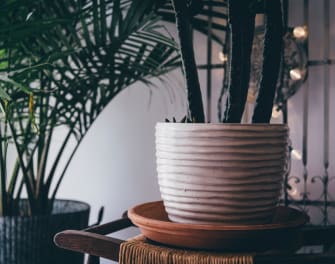When choosing indoor pottery, you’ll want to select what’s suitable for your plants while also picking what will look attractive in your home’s décor. In this post, we’ll share information about several different types of indoor plant pottery materials and offer a few design tips. Note that, although “pot” and “planter” are terms often used interchangeably, we’re referring to pots here—round-ish in shape, intended for one specific plant—not planters that tend to be rectangular, designed to hold multiple plants, often outdoors.

Types of Indoor Plant Pottery Materials
Terra Cotta Pots
When you first think of indoor pottery, you might imagine traditional terra cotta, natural-looking reddish-brown pots that are often unglazed. The term “terra cotta” is Italian, translated into “baked earth” because these pots are made out of clay. They’re usually an affordable choice. Plus, plants typically grow well in them with air and moisture able to effectively circulate in them (which can help to prevent root rot and soil diseases)—and can be especially good for plants that appreciate well-drained soil. That’s why cacti and other succulents do well in the drier soil found in terra cotta pots. A couple of caveats: these porous pots can break easily if dropped or knocked over; plus, you may need to water plants more often in them.
Indoor Ceramic Pots
If you’re looking for a beautifully versatile way to display your plants and flowers in your home, indoor ceramic pots provide plenty of options. They’re available in gorgeous hues and are glazed, inside and out, in a range of shapes and sizes. More durable than terra cotta (and more substantial than plastic), they’re less likely to break if you drop or knock them over. Although indoor ceramic pots are less porous than terra cotta, they have enough porosity to provide your plants with the air and moisture they need—and they can be a good choice for plants that prefer moist conditions. Some of the larger and/or more elaborately decorated ceramic pots may have a higher price point than ones made from terra cotta.
Plastic Pots
If you’re looking for indoor plant pottery that’s versatile, affordable, and lightweight, then plastic pots may be the right choice. They come in a rainbow of colors in multiple styles and, many times, they mimic other materials, such as terra cotta or concrete. Price points depend on the quality and durability with cheap ones cracking fairly easily. Many are made from recycled plastic, making them an environmentally friendly choice, and they can be a wonderful option for plants that love moisture and for people who don’t water their plants as often. In fact, you’ll want to avoid overwatering plants in plastic pots because it can create an environment that’s too soggy for plant health.
Fiberglass Pots
Plants typically thrive in the lightweight yet extremely durable fiberglass pot. Crafted from fiberglass and resin, they add a touch of style to home décor, often having the appearance of other materials: stone, wood, and so forth. Plus, they can be created in a wide variety of styles, having fewer design restrictions than other types. Fiberglass pots are low maintenance, being water-, chemical- and fade-resistant, and you can typically get long use out of them. The outside can fray over time, though, and they can be more brittle than a similar plastic pot. Because fiberglass is non-porous, these pots will hold onto moisture for a longer amount of time, so water appropriately.
Wood & Metal Pots
If you like the natural look, you may want to go with wood and/or metal pots. They’re not as commonly used, but you may see that as a benefit. After all, who wants indoor plant pottery that looks exactly like what everyone else uses? Wooden containers come in a variety of sizes and styles with quality ones often being long-lasting. They can be pretty inexpensive; make sure, though, that any metal fasteners used are corrosion resistant. Metal containers can add a modern look to homes, coming in eye-catching sizes and styles. They can also last a long time, but make sure that the material is rust resistant, and don’t overwater.
Concrete Pots
Plants can grow well in concrete pots, and they’re available in a range of sizes, shapes, and textures. Generally quite affordable, large pots can come at a higher price point than other materials while also being heavy to move. Today’s options are sometimes mixed with lighter-in-weight materials to give you the look of concrete without the heft.
Design Tips for Indoor Plant Pottery
- Choose pottery that highlights the plant. If, for example, you have a beautifully variegated plant, you might want a more subtle pot design that will highlight the leaves.
- If your plant will flower (even if it isn’t now), make sure the color will complement with pot hues, not clash with them.
- Pick a pot that’s right sized for your plant while also considering the proportion. A delicate flowering plant, for example, will be swallowed up by a pot with a hefty design.
- Consider the design of your home. If you’re going for a monochrome look, a white pot can achieve that in a room with white walls. For a more dramatic effect, pick vibrantly colored indoor pottery to go in that white room.
- A pot that will go on a coffee table will likely need to be smaller than one intended to highlight a corner of the room.
Indoor Pottery at Decker’s Nursery
We believe in inspiring you to connect with the natural world by enhancing your surroundings, including indoors—and our expert team is here to help. Stop by our full service retail garden center during business hours or, for help in finding just the right indoor pottery, contact us online, call (631) 261-1148, or email us at hello@deckers-nursery.com.
